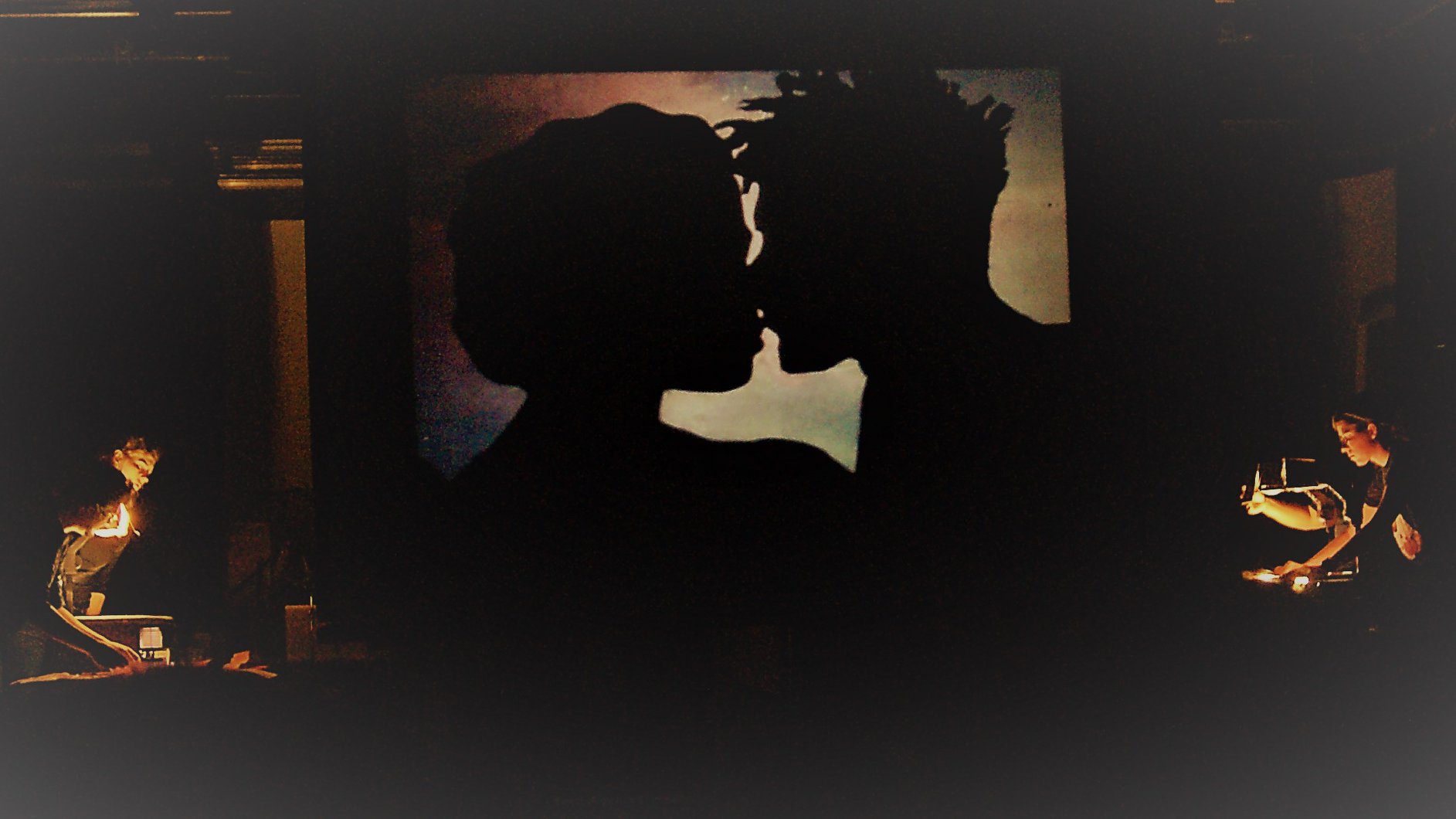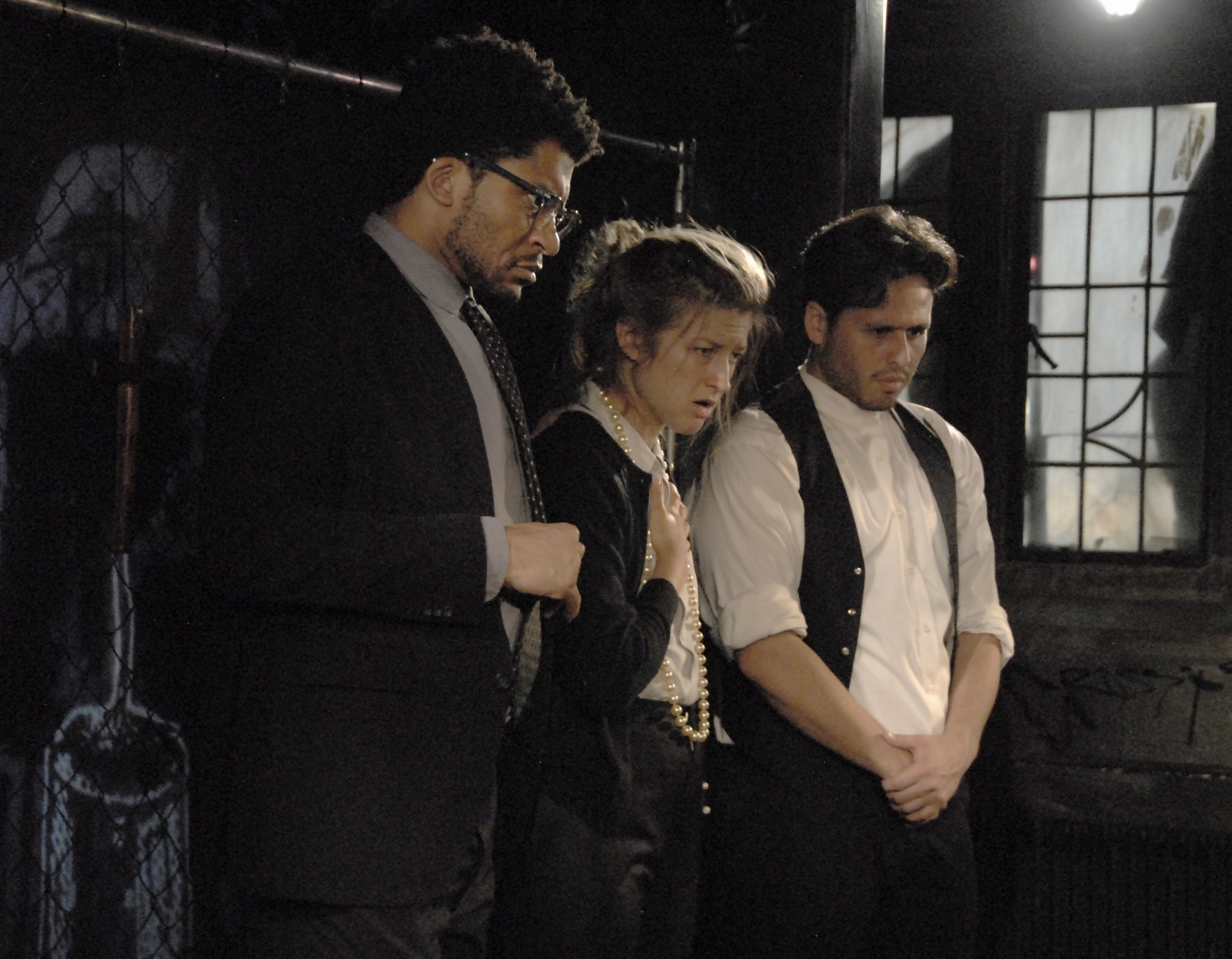Review of The Satellite Festival, Yale Cabaret
Sprawling over three nights from 8 p.m. to midnight, in seven locations, and comprised of 19 different offerings, including musical performances, theater, videos, and multimedia events, the Yale Cabaret’s Satellite Festival, now in its third year, makes for a varied experience. Attendees determine for themselves how much to see and which pieces. With admission times at 8 p.m. and 10 p.m., from March 29th through March 31st, the schedule demanded a certain flexibility and a willingness to move around if one wished to see as much as possible. What follows are some impressions of the performance pieces I saw.
The provocative title of Michael Costagliola’s Hey Secret Service—This is My Official & Genuine Threat to Assassinate Donald J. Trump: The Musical meant it was not to be missed. The show combined video graphics with a cabaret-style presentation of songs by Costagliola, a third-year sound designer.
The key historical referent of the show was the plan to assassinate Trump hatched by Michael Stephen Stanford, a British citizen, in June, 2016, while Trump the media-star was campaigning for the highest political office in the nation. Singing from Stanford’s perspective, Costagliola deftly scored points for the violent overthrow of the current president, the virtues of musical theater, and the dismaying number of murders that would be necessary before one might arrive at someone who, in the succession to the country’s chief executive office, might be ascribed basic decency. Strumming a guitar, accompanied by piano, with odd heckling from the guy at the soundboard, Costagliola, as Stanford, also interacted with his confused but supportive mother via the internet.
Stanford, presented as something of a well-meaning naïf, determines that violence is the key to taking back the government from someone manifestly incompetent, what’s more, he argues, U.S. law allows the government to kill anyone deemed a threat to the nation’s welfare. So, offing the individual who poses the biggest threat to our collective welfare would have to be seen as an act of patriotism. Clever, indeed. And even cleverer was the song in which—citing how incensed Trump became about the reception afforded Vice President Pence at his attendance of Hamilton—Costagliola asserts that we may need no greater weapon than musical theater to bedevil our fatuous First Citizen.
Whether or not one would endorse Sonny Perdue as president, the litany of unacceptable candidates in line between Trump and the Secretary of Agriculture leaves one with a grim sense of the sad state of affairs. Ironic, funny, tuneful, Hey Secret Service… is a creditable and very American act of theater as provocation.
Hey Secret Service—This is My Official & Genuine Threat to Assassinate Donald J. Trump: The Musical
By Michael Costagliola
Devised with Wlad Woyno Rodriguez
Dramaturgy: Molly FitzMaurice; Design: Wlad Woyno Rodriguez; Associate Sound Design: Emily Duncan Wilson; Music played by Joshua Chu & Emily Duncan Wilson
Yale Cabaret: 3/29, 11:30 p.m.; 3/30, 10 p.m.; 3/31, 8 p.m.
Wolf/Alice by Lucie Dawkins
In the studio space above the Cabaret, third-year director Lucie Dawkins presented a performance piece called Wolf/Alice through all three nights of the Festival. Based on a story in Angela Carter’s The Bloody Chamber, an imaginative reworking of figures from folk or fantasy literature, such as vampires and werewolves, Wolf/Alice depicts the challenged life of a feral child.
Carter’s Alice combines the wolf and the little girl from Little Red Riding-Hood, where the threat and attraction of the bestial contributes to the story’s thrill, and, of course, Lewis Carroll’s ever-inquisitive Alice. The nuns who attempt to rehabilitate the beastly child—played by Anula Naklevar and by Rachel Kenney in an amazingly detailed oversized head-mask—are creepier, in their cyborg-like appearance, than the human-flesh-eating, elderly vampire that Alice eventually takes up with.
The combination of music and puppet-handling made the sequences with the vampire completely involving. The entire enactment, with eerie lighting, haunting music, expressive puppeteering and liberal amounts of blood, was a moody and macabre theatrical work. The vocals by Sylvia D’Eramo, of the Yale School of Music, as the Moon, sometimes in counterpoint to a looped track of her own voice, were particularly effective (even with the incessant din provided by the very loud show occurring simultaneously in the Cabaret below on Friday night).
Wolf/Alice
By Lucie Dawkins
Collaborators: Daphne Agosin, Stephanie Bahniuk, Sylvia D’Eramo, Emma Deane, Roxy Jia, Rachel Kenney, Zoe Mann, Anula Naklevar, Emona Stoykova, Adrienne Wells
Cab Studio: March 29-31, 11 p.m.
On Saturday in the upstairs studio, Yale College junior sculpture major Victoria Blume’s projections of symmetrical, abstract digital art pieces, me, myself, and iPhone, was combined with the solo violin performance by Matthew Woodward (Yale School of Music) of Luciano Berio’s Sequenza VIII. According to Woodward, one of the significant aspects of Berio’s composition is that it is both abstract and absurdist. And, for Blume, the phone is a conduit for creativity, allowing her to manipulate apps in ways not intended.
The loop of Blume’s images and the hypnotic, repetitious nature of Sequenza VIII complemented each other well, even if each was fully self-involved and indifferent to the other. Woodward played clad only in a tight swimsuit-like garment and moved while playing as though he were wandering within the music itself. Blume’s images looked a bit like Rorschach blots become video game backgrounds.
Here were works that, in their non-narrative rigor, let each viewer/listener find their own way. It can be so agreeable to be relieved of the need for interpretation.
me, myself, and iPhone
By Victoria Blume
Cab Studio: 3/29, 8 p.m.; 3/30, 8 & 10 p.m.; 3/31, 8:30 p.m.
Sequenza VIII
By Luciano Berio
Performed by Matthew Woodward
Cab Studio: 3/29, 10 p.m.; 3/31, 8:30 & 10:30 p.m.
Brittany Bland's Sea Witch
Perhaps that lack of interpretive edge went with me into Sea Witch, a shadow puppet show by second-year designer Brittany Bland, inspired and adapted from a play by Genne Murphy, a third-year playwright. Here, there was a narrative relayed in pictures only. The effects achieved by the overlay of the shadow-puppets on background cels were poetic at times, at other times more dramatic.
The story of the Sea Witch, an old fisherwoman, and her interaction with Lia, a “card shark,” and Ozzy, a casino boss, was, to me, murky at best. Suffice to say there was a traumatic backstory. The images, some beautiful, some more disturbing, accompanied by music and live Foley by Kathy Ruvuna, created a trance-like experience. Like a dream, meaning seemed subordinated to intangible effects such as the play of light and color in the background of the black foreground images.
Sea Witch
Proposed by Brittany Bland
Inspired by and adapted from a play by Genne Murphy
Adaptor, proposer, puppeteer: Brittany Bland; Puppeteers: Wlad Woyno Rodriguez, Laurie Ortega-Murphy; Live Foley: Kathy Ruvuna
Annex: 3/30, 9 p.m.; 3/31: 9:30 & 10:30 p.m.
All three nights, the African-American Cultural Center at Yale featured third-year director Shadi Ghaheri’s Post Scream and Terror. “A theatrical experiment about Love, Sex and Beauty,” the show brought female performers together to enact a series of entitled segments, some solo, some relational, some songs, some mostly interpretive movement. The sequence of the segments was determined by audience members pulling cards from a hat, with the proviso that the evening ends with the segment called “Crave,” after Sarah Kane’s play. The program lists Kane’s name among a number of “known and unknown female artists” that inspired the various pieces. Between segments, at times, one of the performers might comment or reminisce, the seeming informality drawing attention to the way the entire work moved through all four women—Ghaheri, Patricia Fa’asua, Kineta Kunutu, Juliana Aiden Martinez—in succession and at once.
At times there was a deliberate playfulness or childishness to the performance, as when Ghaheri introduced the show while rocking on a rocking horse or when Martinez rode around on an oversize tricycle. Some titles were simply the name of the performer, as for instance “Tricia” for Fa’asua’s stirring a cappella vocal, or “Ilia” for Ilia Paulino’s song, accompanying herself on guitar. Others, such as “Rope,” named the main prop, a long rope that both divided and united Ghaheri and Kunutu.
The purpose of most of the pieces, it seemed, was the effort to express female experience in both its joyous and oppressive aspects. At one point, in a piece called “Fashion,” three women entered and donned fanciful accessories as a mockery of the catwalk of fashion shows; in another, called “Stephanie,” Stephanie Machado presided over a table of objets before selecting a bracelet and exiting, babbling happily.
The show’s title could be taken to indicate that the lives being depicted have moved past “scream and terror,” so that most of the segments seemed to indicate strength, resilience, and a sense of supportive belonging. The final segment, which began with Fa’asua walking in wide circles reading a long speech from Sarah Kane’s Crave while the others moved about in freeform dance, ended with a delightful valedictory. Moving as one entity, processing out of the playing space on their butts, the women sang and chanted fervently, “fuck that life!”
Post Scream and Terror
By Shadi Ghaheri
Devised and created by Patricia Fa’asua, Shadi Ghaheri, Kineta Kinutu, Juliana Aiden Martinez, Stephanie Cohen, Mika Eubanks, Kathy Ruvuna; with Louisa Gummer, Stephanie Machado, Ilia Paulino, Sohina Sidhu
AfAm House: March 29-31, 11 p.m.
Diverse in its aims and inspiration, the Satellite Festival is a hard event to summarize, its main strength is letting audiences have access to short works, works in development, tech-based and multimedia works, and works that eschew the traditional methods of storytelling for means more expressive and intuitive. Keeping audiences on the move throughout the weekend brings an air of festival to theater, a welcome break from the rhythm of shows with which audiences have become perhaps too comfortable by this point in the season. Made even more ambitious this year by the intention of its curators, Jeremy O. Harris and Amauta Marston-Firmino, to encompass the Cabaret’s history, the Satellite Festival demonstrates again the range of talents and the unexpected collaborations that Yale Cabaret has fostered in its first 50 years.
Yale Cabaret’s 50th Season
Satellite Festival
Curators: Jeremy O. Harris, Amauta Marston-Firmino; Producer: Carl Holvick; Associate Producer: Zak Rosen; Producing Stage Manager: Zachry Bailey; Producing Technical Director: Matt Davis; Producing Sound Director: Roxy Jia; Producing Props Director: Madeleine Winward; Basement Lighting Designer: Ryan Seffinger; Sound Engineer: Noah Gershenson; Stage Manager for Wolf/Alice: Mert Dilek; Stage Manager for CCAM: Joelle Besch
Yale Cabaret and environs
March 29-31, 2018





















